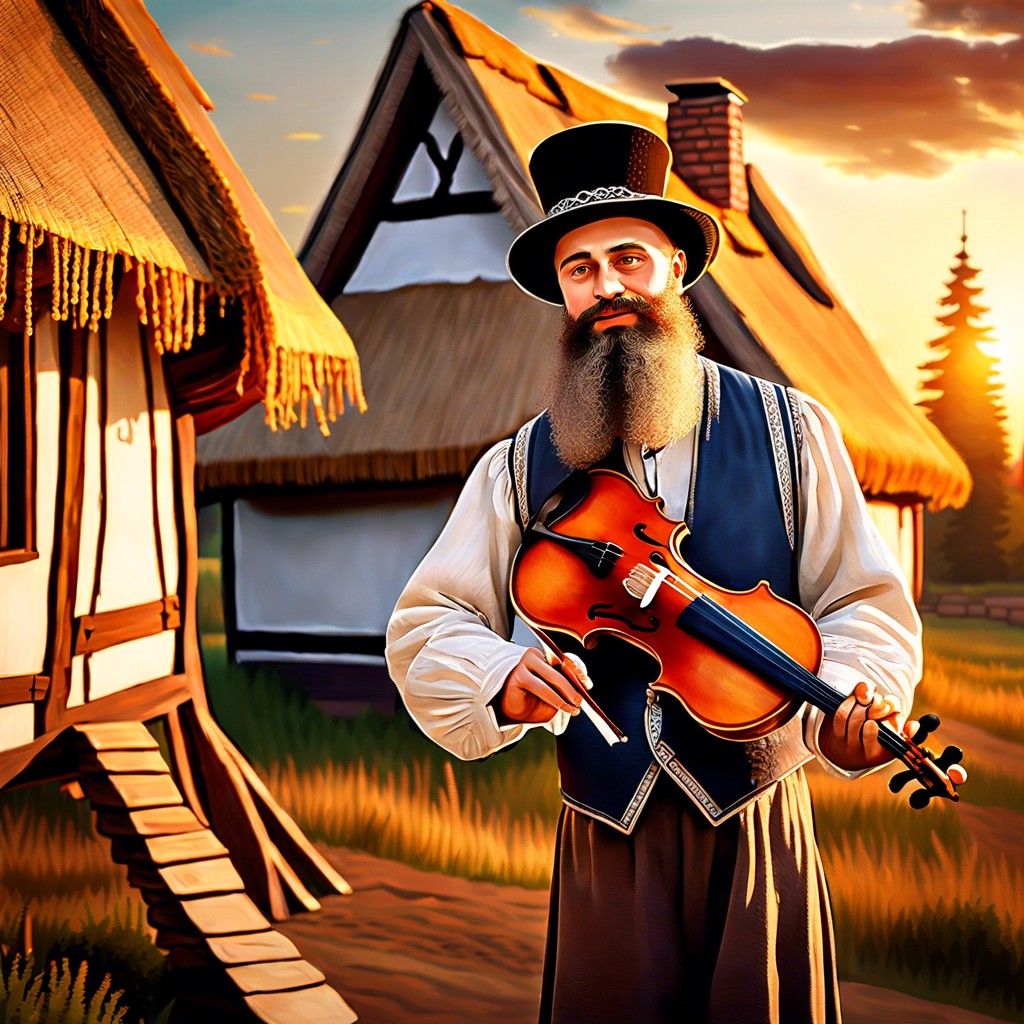Last updated on
This article gives you an overview of the classic musical film “Fiddler on the Roof,” including its plot, characters, and cultural impact.
Key takeaways:
- Plot: Follows Tevye’s struggle to maintain tradition in changing times.
- Cast: Chaim Topol leads an ensemble that brings the story to life.
- Differences: Film adds and removes songs, delves into secondary characters’ backstories.
- Reception: Praised for emotional depth and capturing the essence of shtetl life.
- Awards: Nominated for 8 Oscars, won 3, including Best Cinematography.
Plot

In a small Jewish village in Tsarist Russia, Tevye, a poor milkman, tries to maintain his family and religious traditions while the world around him shifts and pressures his five daughters to choose their own paths. The tale follows his efforts to marry off his daughters against a backdrop of rising anti-Semitism and revolutionary changes. Tevye’s interactions with his strong-willed daughters, who wish to follow their hearts rather than old-world customs, underscore the central theme: the struggle between tradition and progress.
Their stories of love and the pursuit of happiness are interwoven with vibrant song and dance that bring their experiences to life. As each daughter makes her choice, Tevye grapples with the tension between accepting change and remaining true to his deeply held beliefs. The narrative unfolds with humor and heartache, culminating in a bittersweet resolution that reflects the resilience of the human spirit in the face of adversity.
Cast
A troupe of versatile actors brings “Fiddler on the Roof” to life. Leading the pack is Chaim Topol as Tevye, the dairyman whose warmth and wit carry the film. He is flanked by Norma Crane, who portrays his stalwart wife, Golde, with depth and resilience. Tevye and Golde’s daughters, key to the plot’s romantic entanglements, are portrayed by Rosalind Harris, Michele Marsh, and Neva Small, who each encapsulate their character’s youthful hope and defiance.
The film’s emotional gravity is further anchored by Molly Picon and Leonard Frey, playing Yente the matchmaker and Motel the tailor, respectively. Their performances inject humor and pathos in equal measure, deepening the movie’s narrative tapestry. Notably, Frey’s portrayal of Motel earned him an Academy Award nomination.
Paul Mann fills the shoes of the stern yet profound Lazar Wolf, adding to the ensemble’s multi-layered dynamics. The chemistry among the cast members enriches the cinematic experience, ensuring every song and scene resonates with the audience.
In essence, the film’s cast doesn’t just recite lines; they weave a vibrant, emotional community that transports viewers straight to the shtetl of Anatevka, grounding the storytelling in authentic human connections. Their portrayals go beyond mere acting—they live their characters, making the world of “Fiddler on the Roof” as palpable as the chairs we sit in to watch their stories unfold.
Differences From the Broadway Musical
While both the film and Broadway musical share the same skeleton—a story of Tevye, a Jewish milkman, grappling with his daughters’ desires to marry for love rather than tradition—the adaptations have slight variances. The film takes liberties with some musical numbers, removing several songs including “Now I Have Everything” and “The Rumor.” On the other hand, it adds picturesque scenes not present on stage, like the lush, extended sequence of “Tevye’s Dream,” to exploit the possibilities of the cinematic medium.
Character development also shifts in the movie, which tends to offer a deeper dive into secondary character backstories, such as Constable and Fyedka, than the stage version does. Moreover, the film’s sequence of events is rearranged to accommodate its more expansive storytelling canvas. For example, in the movie, Perchik’s arrest precedes the pogrom, unlike in the stage version, highlighting the increasing tension the characters face.
Lastly, the film offers a visual splendor that the stage naturally limits. Settings like the expansive wheat fields and the bustling town market in Anatevka contribute to an immersive experience and transform the way viewers perceive the story’s context, lending a dramatic yet intimate feel to Tevye’s tale.
Reception
Upon its release, the film swept audiences off their feet with its poignant mix of humor and heartache. It resonated with viewers across the globe for its portrayal of human experiences—love, ambition, and the struggle for cultural preservation against the tide of changing societal norms. Critics applauded the film’s emotional depth, with many highlighting Topol’s portrayal of Tevye as a standout performance that brought both warmth and complexity to the screen.
The cinematic adaptation of this stage classic managed to capture the essence of life in the shtetl, thanks to Norman Jewison’s dedicated direction and Oswald Morris’s evocative cinematography. The movie also kindled a love for musical cinema in a new generation, knitting together a tapestry of traditional tunes and vivid storytelling.
While some argued that the film’s 181-minute runtime felt lengthy, others found that every minute was essential to fully immerse the viewer in the world of Anatevka. “Fiddler on the Roof” was recognized for its exceptional contribution to the film musical genre and has been cherished as a cultural touchstone for over 50 years.
Awards and Nominations
“Fiddler on the Roof” waltzed away with a clutch of accolades upon its release. Directed by Norman Jewison, this 1971 film adaptation swirled into the spotlight with eight Oscar nominations. It triumphed in three categories: Best Sound, Best Music, and Best Cinematography, a testament to its audio-visual splendor. The Golden Globes were equally charmed, showering the film with two wins for Best Motion Picture – Musical or Comedy and Best Actor for Topol’s indelible portrayal of Tevye. Moreover, in the years following its premiere, its legacy has been honored with an array of film awards and retrospective acknowledgments, echoing its enduring resonance with audiences and critics alike.





